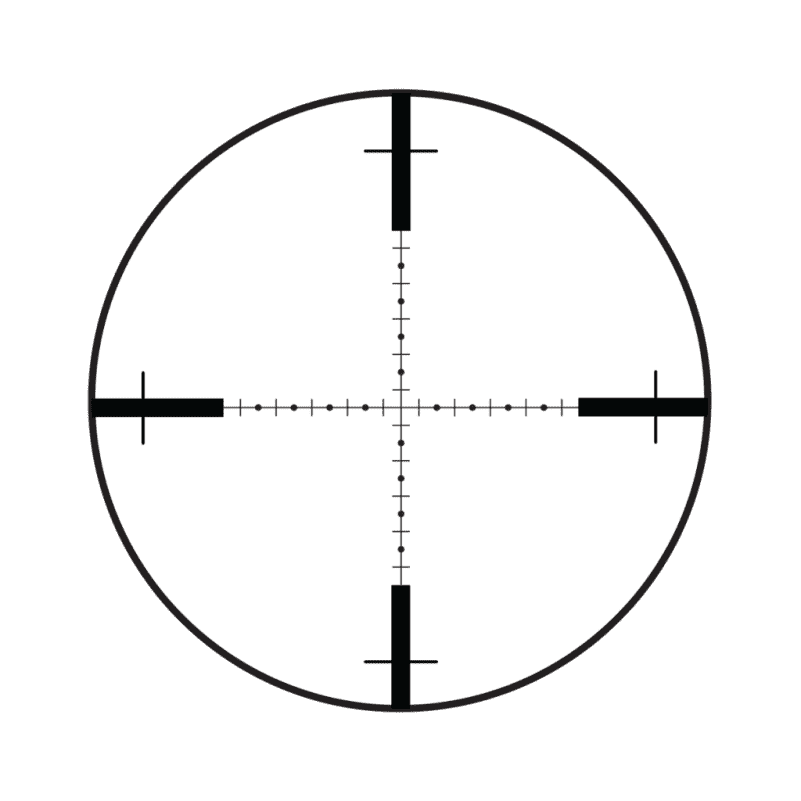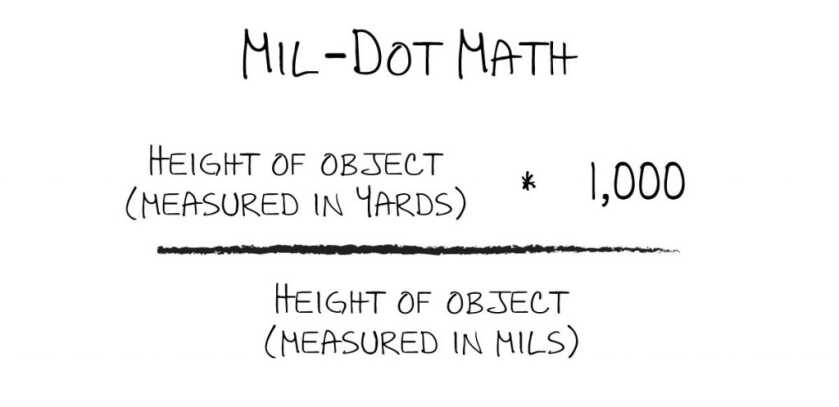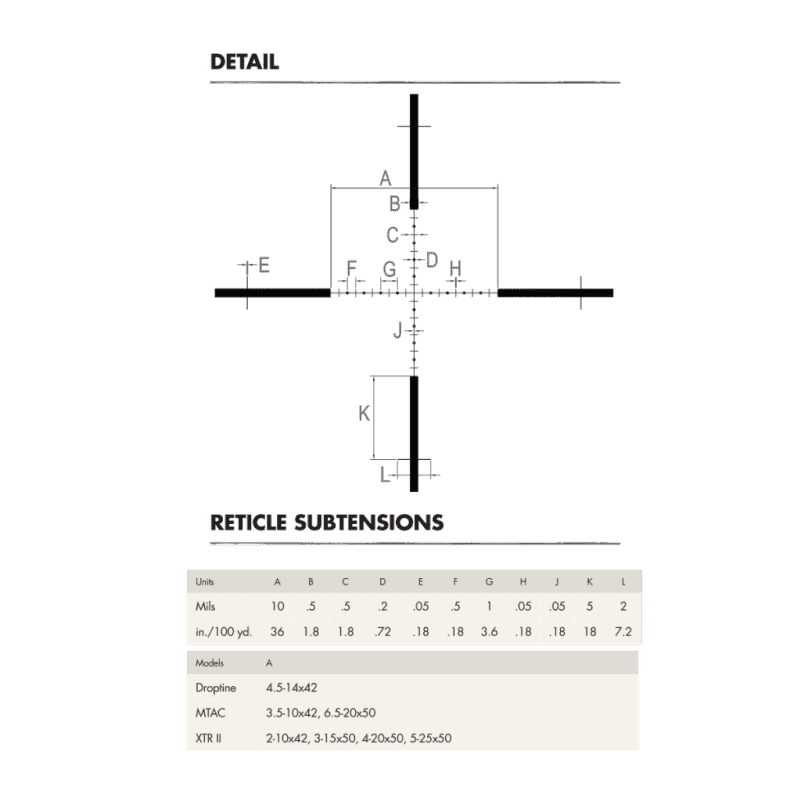

To find range to your target, you could make use of technology and use a scope with integrated laser rangefinder like the Burris Eliminator (bottom). Or, with some basic math, you can use a scope with a graduated mil-dot or MOA reticle like the Burris Veracity (top).

THE SERIES
- Part 1: Optics Buying Guide: Iron Sights, Red Dots, and Scopes
- Part 2: Optics Buying Guide: Top Must-Know Terms for Picking the Right Scope
- Part 3: Optics Buying Guide: Scope Mounts
- Part 4: Optics Buying Guide: How To Properly Zero Your Scope
- Part 5: Optics Buying Guide: Finding Your Range with a Scope Reticle
- Part 6: Optics Buying Guide: Hold Off vs. Adjustable Scope Turrets
- Part 7: Optics Buying Guide: Scope Reticles
- Part 8: Optics Buying Guide: Using a Laser Rangefinding Scope
- Part 9: Optics Buying Guide: Holographic and Red Dot Optics
- Part 10: Optics Buying Guide: AR-15 Optics and Scopes
- Part 11: Optics Buying Guide: Big Scopes
- Part 12: Optics Buying Guide: Do You Get What You Pay For?
Sometimes it’s good to know how to do things the “old-school” way without all the electronic gadgets and gizmos. For shooting at anything past 200 yards, and even less with some calibers, it’s pretty important to know how far away that thing is. The very nanosecond a bullet leaves the fiery end of your rifle, gravity takes over, and it begins to fall. The farther it goes, the more it falls. Just to illustrate how dramatic the bullet drop can be, let’s look at the most common rifle cartridge scenario. A 55-grain bullet, fired from an AR rifle with a 50-yard zero will drop over 99 inches by the time it travels 600 yards. That’s over eight feet! The better information you have about your target distance, the more likely you’ll hit it.
Fortunately, you can figure out how far away an object is using nothing more than your scope, provided its reticle has markings in either mil dots (so named because the “distance” between the centers of two adjacent dots is one milliradian) or minutes of angle. Using these marks to determine distance is not different than estimating using your thumb. Let me explain what I mean…
Sitting here at my desk, I can look out my window and see my neighbor’s porch. If I hold my thumb up at arm’s length, it covers an eight-foot section of their front porch rail. Right now, I have two pieces of “known” information: the width of my thumb and the width of a normal front porch rail segment. Those first two pieces of data don’t change, so if I acquire one more bit of info, I can use these three pieces of information to determine the distance to any eight-foot porch rail segment using my thumb. Fortunately, I have a Burris Eliminator III scope with built-in laser range finding sitting here on my desk. I now know that my neighbor’s porch is 73 yards from my desk. This is the missing 3rd piece of information.

This Burris G2B is a classic example of a mil-dot reticle, so named because the “distance” between the centers of two adjacent dots is one milliradian.
Since most of the porch rail segments on my street are eight feet, probably because that’s a standard length of 2×4 lumber, I can now estimate the range of various porches using only my thumb. If I hold my thumb up and compare it to another neighbor’s porch rail, all I have to do is estimate how much of my thumb the rail covers. For example, if I look at a porch rail, and it covers exactly half of my thumb, then I know that porch is 146 yards away, or double the distance of the known one. If looks like 1/4 of a thumb width, then that porch is 292 yards away, or four times the distance of the reference porch. Hey, we just did some basic algebra using only 2x4s and thumbs!
The process of estimating using the marks on your scope reticle is basically the same. Let’s illustrate this concept using a type of scope reticle that was designed for easy ranging of targets – the classic mil-dot. Here, we’ll use the Burris G2B Mil-Dot reticle. It’s available on a bunch of Burris optics and is pretty standard as far as mil-dot reticles go. The idea is similar to the thumb example. A mil-dot is literally just that – a dot on the scope reticle. Each dot is separated by an exact distance referred to as one “mil” or milliradian. OK, technically a mil is not a distance measurement, but rather an angular one. That angle specifies an exact distance down range. To be really precise, if you measure the distance between the center of one dot and the center of the next one, that’s exactly one mil. One mil translates to exactly one yard at 1,000 yards down range. Just like our thumb and porch example, if I look through a scope with a mil-dot reticle and a one-yard wide or tall object covers exactly the distance between the centers of two adjacent dots, then that object must, by definition, be exactly 1,000 yards away.
Since in the real world, there are relatively few one-yard tall or wide objects that cover exactly one mil when we look at it through the scope reticle, we need to apply a little math to account for different sized objects and fractions or multiples of mils that it covers when we look through the reticle. While the math is basically beginning algebra, in practical terms it’s a lot simpler than that. You can forget all the theoretical math and just memorize a very simple equation that just works.

Now, to show how this formula works, let’s plug in the known values I just referenced. That would be the fact that one mil represents a one-yard tall or wide object 1,000 yards down range.

Since mils are an angular measurement, the above formulas also work with meters instead of yards, provided you use meters for the actual size of the object. Of course, the formula will then give you the distance in meters too.
So that’s the theoretical math. Now let’s put it to work in an everyday example. You know, something you would do frequently, like range Star Wars droid R2D2. It just so happens that R2D2 is about 1 meter tall. Technically, at least according to Wookieepedia, he’s exactly 1.09 meters tall, and I only say “he” because the site claims he has “masculine programming.”
In the simulated view of R2D2 though the scope using the G2B Mil-Dot reticle, you can see that our favorite little droid appears to be four mils tall. Remember, we’re measuring to the middle of the top dot. As a result, since he’s one-meter tall, the formula shown indicates that he’s 250 meters down range. See how useful this is? The math tells you that you are well out of Light Saber range.
To take this to the next level, let’s consider a totally different example where the object we’re ranging is not exactly one-meter tall. No worries, the formula works exactly the same way. Let’s suppose your target, whether wild hog, ISIS terrorist, or C-3PO is standing next to a 1970 AMC Gremlin. As everyone knows, that car is exactly 51.8 inches tall. Since the magic ranging formula relies on yards, we first have to figure out how many yards 51.8 inches is. Since one yard is 36 inches, the Gremlin is 1.438 yards tall. If you look at the Gremlin through your mil-dot scope, you might see that it appears to be 2.5 mils high. So, using the magic formula, multiply 1.438 yards times 1,000, then divide by 2.5. That tells you that the Gremlin and your target standing next to it are 575.2 yards down range.
I use the Gremlin example because it’s easy to find objects in the real world that might be near your target, and many objects are of standard size. With some work and notes in your log book, you can find all sorts of everyday things like fence posts, tank treads, light poles, fire hydrants, vehicles, or whatever else may be in your area, and memorize their sizes.
The other trick is to learn the measurements of your scope reticle so you can get precise about determining how many mils tall or wide your target is. So far I’ve only mentioned that the distance between two mil dots center to center is one mil. Using the Burris G2B Mil-Dot reticle, we can see there are a lot more tools available. For example:
- The mil-dots themselves are .2 mils in diameter.
- The thickness of the actual crosshairs is .05 mils.
- The hash marks are .5 mils.
- The thickness of the heavy bars on the outside of the reticle is .5 mils.
- The height of those thick bars from the end to its hashmark is 5 mils.

There are a surprising number of known measurements you can use in a basic mil-dot scope. it pays to know your equipment.
Using these smaller measurements, you can more precisely gauge an objects size in mils. If R2D2 is somewhere between two and three mils, you can use the smaller reticle marks to arrive at the fraction of a mil between two and three. For example, R2 might be two full mils plus one mil-dot diameter, so the total measurement is 2.2 mils.
What about Minute of Angle (MOA) scopes?
Since one of the design goals of the mil-dot system was easy range estimation, the formula is simple if you input the object size in meters or yards. If you have a scope that has a minute of angle (MOA) reticle marks, you can still range, you just need to use a different formula. The structure is the same, the constant number is just different to account for the conversion of minutes of angle.

While the 95.5 multiplier will get you closer, you can substitute an even 100 to keep things simple in the field.
A gotcha?
There’s one gotcha you need to be aware of. As we briefly touched on in Part 2 of the Optics Buying Guide, the listing of must-know terms, there are two types of variable power scopes, first focal plane and second focal plane. With a second focal plane scope, the reticle stays the same size in your view as you change magnification. For second focal plane scopes, ranging using the marks on the reticle only works properly at one magnification level, usually the highest. Just check your owner’s manual to be sure. For first focal plane scopes, the reticle grows and shrinks in your view as you change magnification. Since the reticle changes in proportion with the magnification level, the methods we’ve discussed here work at any magnification level.
Know thy scope
In the examples here, we’ve focused on the classic mil-dot reticle design, mainly because it’s designed for both ranging and shot adjustment. However, nearly any scope with graduations marks on the reticle will work. Check your owner’s manual and you’ll almost certainly find a chart that shows you exactly how many mils or minutes of angle that various marks represent. The more you know about your particular reticle, the better it can work for you for both ranging and shot compensation.

You aren’t limited to a standard mil-dot scope for ranging purposes. Most any reticle, like this Burris CQ, will have information about reticle mark dimensions.
åç
So there you have it. When the world ends and the batteries in your laser rangefinder croak, you can determine ranges just using your scope. Like most things, practice makes perfect, so give it a try. After you range a few things successfully, it will become second nature. Fortunately, the formula is super simple and easy to memorize. After that, it’s just a matter of memorizing the sizes of some objects common to the environment where you’re shooting. If you live on Tatooine, just remember that R2D2 is 1.09 meters tall, and the X-34 Land Speeder is 3.4 meters long.


This is a great format on how , to take and get a long distance shot on target . You have to adjust yout fire to get on target , Practice ! I plan on keeping this fon next time I go to the range . I you read it , you will be able to take a long distance shot in no time . With breathing training ,adjustment of your fire , your going Target every time . .
Great article and it’s been saved for future reference. Thank you.
The above is all great if you are not moving around in combat. The Dragunov reticle is for combat.
Great article! I love how you make these acronyms, MOA, Mils, into real pieces of usable information.
Use the Chewbacca Defense… Relative size comparison of the indigenous species.
https://m.youtube.com/watch?v=xwdba9C2G14
Greatest